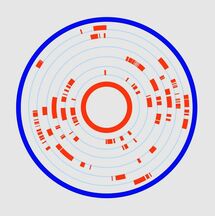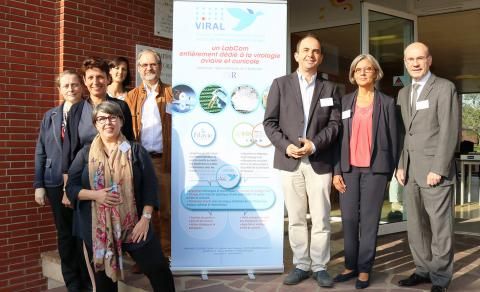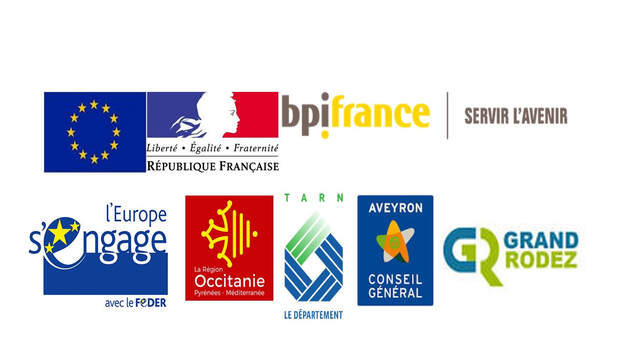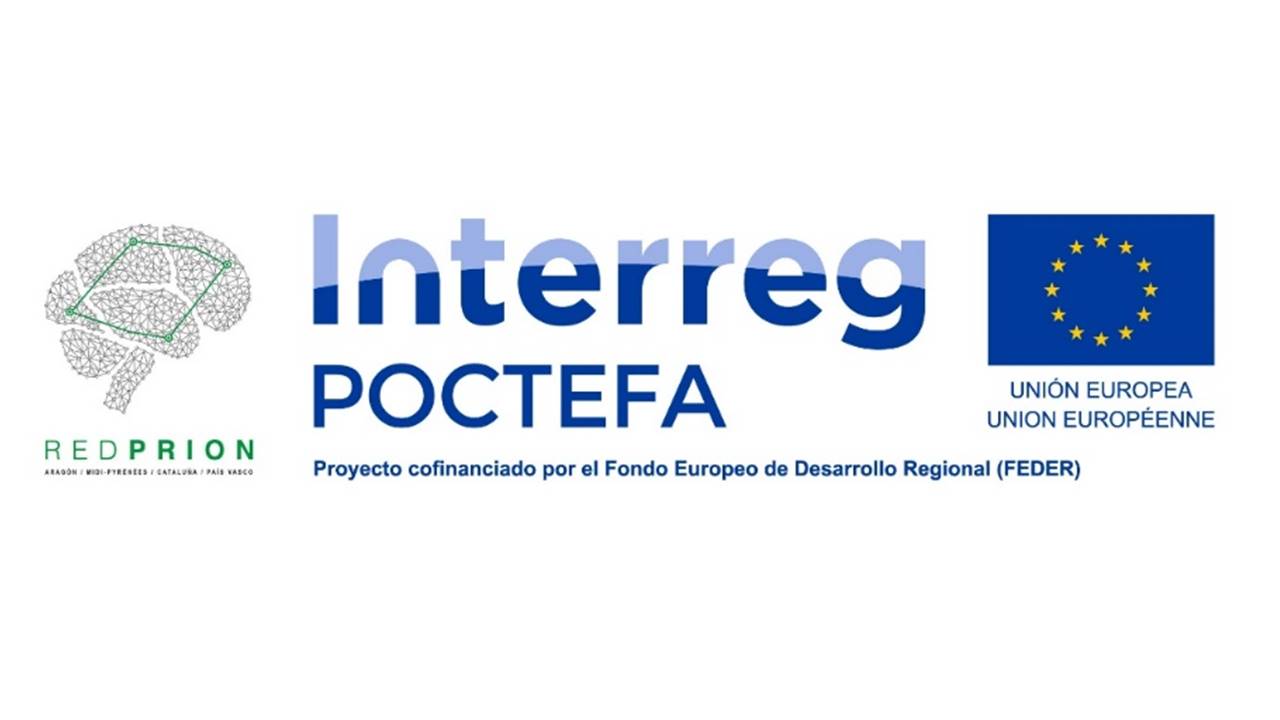For reseacher portraits (in French) click here and here
2018 INRA Awards
The collective Science with an Impact Award goes to the Prion Task Force, whose research over the past 20 years has contributed to safeguarding food and human health from Transmissible Spongiform Encephalopathies (TSEs), also known as prion diseases, of which “mad cow” is the most notorious. For more information click here
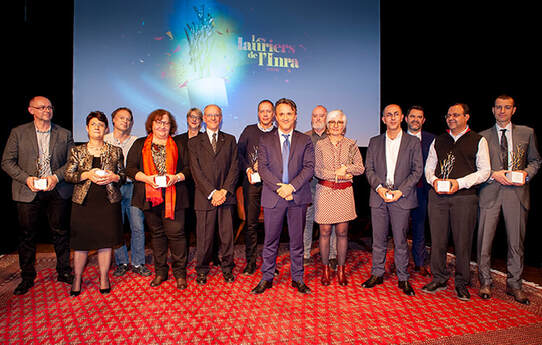
Task force members
The "Prion Task Force” comprises research teams and resources from four INRA centres—Jouy-en-Josas, Toulouse, Clermont-Theix, and Tours—and represents four scientific divisions—Animal Health, Animal Genetics, Animal Physiology and Livestock Systems, and Nutrition, Chemical Food Safety and Consumer Behaviour.
Scientific spokespeople
The "Prion Task Force” comprises research teams and resources from four INRA centres—Jouy-en-Josas, Toulouse, Clermont-Theix, and Tours—and represents four scientific divisions—Animal Health, Animal Genetics, Animal Physiology and Livestock Systems, and Nutrition, Chemical Food Safety and Consumer Behaviour.
Scientific spokespeople
- Olivier Andréoletti, veterinarian and pathologist, UMR IHAP Toulouse
- Vincent Béringue, biochemist, UR VIM, Jouy-en-Josas
- Jean-Michel Elsen, geneticist, UMR GenPhySE, Toulouse
- Human Rezaei, biophysicist, UR VIM, Jouy-en-Josas
- Jean-Luc Vilotte, geneticist and biologist, UMR GABI Jouy-en-Josas
|
Researchers from IHAP and their colleagues at ANSES and the University of Melbourne have demonstrated that some mycoplasmas have the capacity to exchange virtually any part of their genome via a form of sexual behavior. This was further shown to play a role in accelerating the acquisition of chromosomal mutations conferring antimicrobial resistance in ruminant, pathogenic Mycoplasmas.
Faucher M., Nouvel LX, Dordet-Frisoni E, Sagné E, Baranowski E, Hygonenq MC, Marenda MS, Tardy F, Citti C. under experimental antimicrobial selection: The unpredicted contribution of horizontal chromosomal transfer. PLoS Genet. 2019 Jan 22;15(1):e1007910. doi: 10.1371/journal.pgen.1007910. eCollection 2019 Jan. |
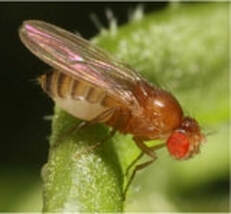
Drosophila, a new model for studying prion neurodegenerative diseases
Researchers from IHAP and their colleagues at the University of Cambridge showed that mammalian prions can be propagated in a model organism, the vinegar fly, Drosophila melanogaster, while retaining all of their biological properties. This first time discovery was published in the journal Brain, July 08, 2018, offers an interesting new model to study the mechanisms of prions replication and to better understand processes leading to neurodegenerative diseases.
Thackray AM, Andréoletti O, Bujdoso R. Mammalian prion propagation in PrP transgenic Drosophila. Brain. 2018 Sep 1;141(9):2700-2710. doi: 10.1093/brain/awy183. |

Lausanne 2018, final competition, my phD in 180s ...and the winner is Geneviève Zabré from Burkina Faso! Congratulations! Watch her great talk by clicking here. The research presented by Geneviève Zabré is part of the project: "Nutritional and antiparasitic quality of four acacia species (Acacia mangium, A. mearnsii, A. nilotica and A. raddiana) in small ruminants on farms of the arid regions of Brazil and Burkina Faso " which involved IHAP.
Zabré Geneviève, Kaboré Adama, Bayala Balé, Tamboura H. Hamidou, Belem Adrien Marie Gaston, Niderkorn Vincent, Costa Junior Martin Livio, Louvandini Helder, Hoste Hervé, 2017. Botanical and ethnoveterinary surveys of two Acacias (Acacia raddiana and Acacia nilotica) exploited in small ruminant rearing in Sahelian area of Burkina Faso. Animal and Veterinary Sciences, 5(5): 63-68. Doi: 10.11648/j.avs.20170505.11. Zabré Geneviève, Kaboré Adama, Bayala Balé, Katiki Luciana M., Costa-Júnior Livio Martins, Tamboura H. Hamidou, Belem Adrien Marie Gaston, Abdalla Adibe Luiz, Louvandini Helder, Niderkorn Vincent, Hoste Hervé, 2017. Comparison of the in vitro anthelmintic effects of Acacia nilotica and Acacia raddiana. Parasite, 24 (44), 11p. Doi :10.1051/parasite/2017044.
Zabré Geneviève, Kaboré Adama, Bayala Balé, Tamboura H. Hamidou, Belem Adrien Marie Gaston, Niderkorn Vincent, Costa Junior Martin Livio, Louvandini Helder, Hoste Hervé, 2017. Botanical and ethnoveterinary surveys of two Acacias (Acacia raddiana and Acacia nilotica) exploited in small ruminant rearing in Sahelian area of Burkina Faso. Animal and Veterinary Sciences, 5(5): 63-68. Doi: 10.11648/j.avs.20170505.11. Zabré Geneviève, Kaboré Adama, Bayala Balé, Katiki Luciana M., Costa-Júnior Livio Martins, Tamboura H. Hamidou, Belem Adrien Marie Gaston, Abdalla Adibe Luiz, Louvandini Helder, Niderkorn Vincent, Hoste Hervé, 2017. Comparison of the in vitro anthelmintic effects of Acacia nilotica and Acacia raddiana. Parasite, 24 (44), 11p. Doi :10.1051/parasite/2017044.
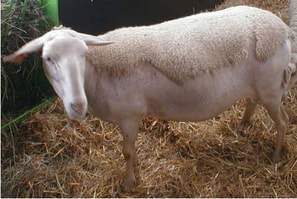
"Du gène au territoire" : a collaborative project on Mastitis between IHAP and the GenPhySE research unit. Click here to see the movie (available in French only). Associated publications: A Point Mutation in Suppressor of Cytokine Signalling 2 (Socs2) Increases the Susceptibility to Inflammation of the Mammary Gland while Associated with Higher Body Weight and Size and Higher Milk Production in a Sheep Model.Rupp R, Senin P, Sarry J, Allain C, Tasca C, Ligat L, Portes D, Woloszyn F, Bouchez O, Tabouret G, Lebastard M, Caubet C, Foucras G, Tosser-Klopp G. PLoS Genet. 2015 Dec 11;11(12):e1005629. doi: 10.1371/journal.pgen.1005629. Whole blood transcriptome analysis reveals potential competition in metabolic pathways between negative energy balance and response to inflammatory challenge. Bouvier-Muller J, Allain C, Tabouret G, Enjalbert F, Portes D, Noirot C, Rupp R, Foucras G.. Sci Rep. 2017 May 24;7(1):2379. doi: 10.1038/s41598-017-02391-y.
|
IHAP and FILAVIE, a company specialized in the development and manufacture of vaccines for poultry and rabbit production, inaugurated the LabCom VIRAL joint laboratory on 23 September 2016.
The detection and characterization of "emerging" viruses are a major challenge in veterinary vaccinology to ensure the relevance of vaccines, their quality and their biological safety. Thanks to the advance in high throughput sequencing technologies (so-called "next-generation" or "NGS" sequencing) and quantitative PCR (detection and quantification of nucleic acid segments) in real-time broadband, this is now possible, offering new perspectives, both scientific and industrial in veterinary medicine. These technologies have been developed for several years at IHAP as part of a collaboration with the genomics and bioinformatics platforms of Toulouse (GeT-Plage and BioInfo Platforms, members of the GenoToul genopole). The LabCom VIRAL project was selected by the National Research Agency (ANR) in May 2015 as part of the call for projects: Joint laboratories public research organizations-SME/ ETI (LabCom). |
|
Oviboost: a project to reduce the use of antibiotics To known more click here (in French only) Réseau transfrontalier de recherche sur les maladies à prions humaines et animales Red de investigación transfronteriza en enfermedades priónicas humanas y animales EFA148/16/REDPRION To known more click here (in French and Spanish only) |

